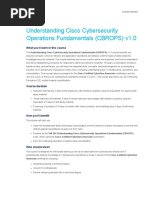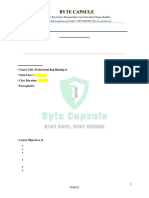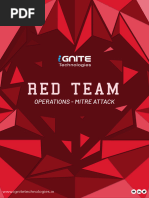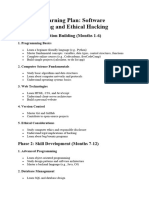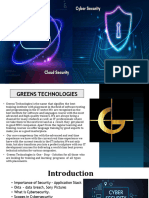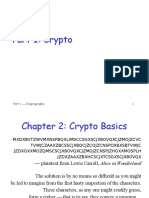OffSec SOC-200 (OSDA)
OffSec SOC-200 (OSDA)
Uploaded by
joommor9872Copyright:
Available Formats
OffSec SOC-200 (OSDA)
OffSec SOC-200 (OSDA)
Uploaded by
joommor9872Copyright
Available Formats
Share this document
Did you find this document useful?
Is this content inappropriate?
Copyright:
Available Formats
OffSec SOC-200 (OSDA)
OffSec SOC-200 (OSDA)
Uploaded by
joommor9872Copyright:
Available Formats
Course Outline & Schedule
Call US 408-759-5074 or UK +44 20 7620 0033
OffSec SOC-200 (OSDA)
Course Code QAOFSECOSDA
Duration 5 Day Course
Price Available on request
Course Description
Learn the foundations of cybersecurity defense with Foundational Security Operations and Defensive Analysis
(SOC-200), a course designed for job roles such as Security Operations Center (SOC) Analysts and Threat
Hunters. Learners gain hands-on experience with a SIEM, identifying and assessing a variety of live, end-to-end
attacks against a number of different network architectures. Learners who complete the course and pass the
exam earn the OffSec Defense Analyst (OSDA) certification, demonstrating their ability to detect and assess
security incidents.
Objectives
Learners will learn how to:
Recognize common methodologies for end-to-end attack chains (MITRE ATT&CK® framework)
Conduct guided audits of compromised systems across multiple operating systems
Use a SIEM to identify and assess an attack as it unfolds live
Target Audience
Security Operations Center (SOC) Tier 1, Tier 2 and Tier 3 Analysts, Jr. roles in Threat Hunting and Threat
Intelligence Analysts, Jr. roles in Digital Forensics and Incident Response (DFIR). Anyone interested in detection
and security operations, and/or committed to the defense or security of enterprise networks.
Perpetual Solutions - Page 1 of 7
Course Outline & Schedule
Call US 408-759-5074 or UK +44 20 7620 0033
Additional Information
About the Exam:
The OSDA Exam Scheduling Open Now
The SOC-200 course prepares you for the OSDA certification
Exam is Proctored
Learn more about the exam here
Course Modules
Module 1 Attacker Methodology (14 topics)
◾ The Network as a Whole
◾ Gain a basic understanding of an enterprise network's DMZ
◾ Learn about deployment environments
◾ Understand the difference between core and edge network devices
◾ Study virtual private networks and remote sites
◾ The Lockheed-Martin Cyber Kill-Chain
◾ Learn the parts of the Lockheed-Martin Cyber Kill-Chain
◾ Apply the Kill-Chain to malware that performed cryptomining
◾ Apply the Kill-Chain to three iterations of ransomware
◾ MITRE ATT&CK Framework
◾ Learn the classifications of the MITRE ATT&CK Framework
◾ Review a case study of OilRig campaigns with MITRE ATT&CK principles
◾ Review a case study of APT3 campaigns with MITRE ATT&CK principles
◾ Review a case study of APT28 campaigns with MITRE ATT&CK principles
Module 2 Windows Endpoint Introduction (25 topics)
◾ Windows Processes
◾ Gain a basic understanding of programs running within Windows
◾ Learn about Windows Services and their relationship with processes
◾ Review the common states of Windows Services
◾ Windows Registry
◾ Review the configuration structure of theWindows Registry
◾ Learn about the key-value pair relationship within the Windows Registry
◾ Understand the value types and formats for Windows Registry keys
Perpetual Solutions - Page 2 of 7
Course Outline & Schedule
Call US 408-759-5074 or UK +44 20 7620 0033
◾ Command Prompt, VBScript, and PowerShell
◾ Review the non-graphical means of interacting with Windows
◾ Build batch scripts used for the command prompt to run local commands
◾ Write a Visual Basic Script for collecting operating system
◾ Build custom PowerShell functions
◾ Programming on Windows
◾ Review the Component Object Model in Windows
◾ Learn about the development of the .NET Framework and .NET Core
◾ Windows Event Log
◾ Gain a basic understanding of Windows Event logs and sources
◾ Review several Windows Event logs using the Windows Event Viewer
◾ Use PowerShell to query Windows Event logs
◾ Empowering the Logs
◾ Gain a basic understanding of System Monitor Sysmon)
◾ Review Sysmon events using the Windows Event Viewer
◾ Review Sysmon events using PowerShell
◾ Use PowerShell Core in Kali Linux to query event logs remotely
Module 3 Windows Server Side Attacks (13 topics)
◾ Credential Abuse
◾ Learn about the Windows Security Account Manager
◾ Learn about Windows Authentication
◾ Understand the concept of suspicious login activity
◾ Evaluate the behavior of brute-force login activity
◾ Web Application Attacks
◾ Learn about the configuration of Internet Information Services IIS in Windows
◾ Evaluate logging artifacts of local file inclusion for attacking web servers
◾ Evaluate logging artifacts of command injection and file upload for attacking web servers
◾ Binary Exploitation
◾ Learn about binary attacks through buffer overflows, and the artifacts they create
◾ Study the use of Windows Defender Exploit Guard and how it protects against binary exploitation
◾ Evaluate logging artifacts generated by the Windows Defender Exploit Guard
Module 4 Windows Client Side Attacks (11 topics)
◾ Attacking Microsoft Office
◾ Review social engineering and spearphishing techniques
◾ Evaluate the use of Microsoft Office products to deploy phishing attacks
Perpetual Solutions - Page 3 of 7
Course Outline & Schedule
Call US 408-759-5074 or UK +44 20 7620 0033
◾ Review logging artifacts generated from a phishing attack
◾ Monitoring Windows PowerShell
◾ Gain a basic understanding of extended PowerShell logging capabilities
◾ Understand the use of PowerShell module logging
◾ Understand the use of PowerShell script block logging
◾ Understand the use of PowerShell transcription
◾ Review PowerShell logging artifacts generated from a phishing attack
◾ Learn about PowerShell obfuscation and deobfuscation
Module 5 Windows Privilege Escalation (8 topics)
◾ Privilege Escalation Introduction
◾ Gain a basic understanding of Windows integrity levels and enumeration
◾ Learn about Windows' User Account Control UAC
◾ Evaluate a UAC bypass technique and the logging artifacts it creates
◾ Escalations to SYSTEM
◾ Perform an elevation using UAC Bypass and review the logging artifacts created
◾ Learn about service permissions for privilege escalation along with relevant logging artifacts
◾ Learn about unquoted service paths for privilege escalat
Module 6 Linux Endpoint Introduction (9 topics)
◾ Linux Applications and Daemons
◾ Understand what Linux daemons are
◾ Understand the Syslog Framework components
◾ Understand how the syslog and the journal daemon work together
◾ Understand Linux web logging
◾ Automating the Defensive Analysis
◾ Understand how scripting can aid log analysis
◾ Understand how to scale further scripting with DevOps tools
◾ Understand how to put together what we learned in a real-life hunting scenario
Module 7 Linux Server-Side Attacks (6 topics)
◾ Credential Abuse
◾ Understand suspicious logins and how to detect them in logs
◾ Understand brute-force password attacks and their log footprints
◾ Web Application Attacks
◾ Understand command injection attacks and their log footprint and detections
Perpetual Solutions - Page 4 of 7
Course Outline & Schedule
Call US 408-759-5074 or UK +44 20 7620 0033
◾ Understand SQL injection attacks and their log footprint and detections
Module 8 Linux Privilege Escalation (6 topics)
◾ User-side privilege escalation attack detections
◾ Understand how Linux privileges works
◾ Understand how to detect privilege escalation attacks on user's configuration files
◾ System-side privilege escalation attack detections
◾ Understand how Linux privileges works
◾ Understand how to detect privilege escalation attacks on user's configuration files
Module 9 Windows Persistence (7 topics)
◾ Persistence on Disk
◾ Understand and recognize Persisting via Windows Service
◾ Understand and recognize Persisting via Scheduled Tasks
◾ Understand and recognize Persisting by DLLSideloading/Hijacking
◾ Persistence in Registry
◾ Understand Using Run Keys
◾ Understand Using Winlogon Helper
Module 10 Network Detections (10 topics)
◾ Intrusion Detection Systems
◾ Understand theory and methodologies behind IPS and IDS
◾ Understand Snort rule syntax
◾ Learn how to craft basic Snort rules
◾ Detecting Attacks
◾ Learn how to detect known vulnerabilities with Snort rules
◾ Learn how to detect novel vulnerabilities with Snort rules
◾ Detecting C2 Infrastructure
◾ Understand the components of a C2 framework
◾ Learn how to detect a well-known C2 communication through Snort rule sets
Module 11 Antivirus Detections (16 topics)
◾ Antivirus Basics
◾ Understand an Overview of Antivirus
Perpetual Solutions - Page 5 of 7
Course Outline & Schedule
Call US 408-759-5074 or UK +44 20 7620 0033
◾ Understand Signature-Based Detection
◾ Understand Heuristic and Behavioral-Based Detection
◾ Antimalware Scan Interface AMSI
◾ Understand the basics of AMSI
◾ Understand how attackers bypass AMSI
◾ Active Directory Enumeration
◾ Abusing Lightweight Directory Access Protocol
◾ Understand LDAP
◾ Interact with LDAP
◾ Enumerate Active Directory with PowerView
◾ Detecting Active Directory Enumeration
◾ Audit Object Access
◾ Perform Baseline Monitoring
◾ Use Honey Tokens
Module 12 Network Evasion and Tunneling (12 topics)
◾ Network Segmentation
◾ Understand the concept of network segmentation
◾ Learn the benefits of network segmentation
◾ Understand possible methods of implementing network segmentation in an enterprise
◾ Detecting Egress Busting
◾ Understanding the concept of egress filtering
◾ Understanding an iptables firewall setup and application of egress filtering
◾ Evaluate an 'egress busting' technique and the logging artifacts it creates
◾ Port Forwarding and Tunneling
◾ Understand the concept of tunneling and port forwarding
◾ Learn how attackers use it to compromise additional machines in the network
◾ Understand the possible methods and tools attackers use to tunnel into the network and how to detect
them
Module 13 Windows Lateral Movement (12 topics)
◾ Windows Authentication
◾ Understanding Pass the Hash
◾ Understanding Brute Forcing Domain Credentials
◾ Understanding Terminal Services
◾ Abusing Kerberos Tickets
◾ Understanding Pass the Ticket
Perpetual Solutions - Page 6 of 7
Course Outline & Schedule
Call US 408-759-5074 or UK +44 20 7620 0033
◾ Understanding Kerberoasting
◾ Active Directory Persistence
◾ Keeping Domain Access
◾ Understanding Domain Group Memberships
◾ Understanding Domain User Modifications
◾ Understanding Golden Tickets
Module 14 SIEM Part One: Intro to ELK (7 topics)
◾ Log Management Introduction
◾ Understand SIEM Concepts
◾ Learn about the ELK Stack
◾ Use ELK Integrations with OSQuery
◾ ELK Security
◾ Understand Rules and Alerts
◾ Understand Timelines and Cases
Module 15 SIEM Part Two: Combining the Logs (12 topics)
◾ Phase One: Web Server Initial Access
◾ Detect enumeration and command injection
◾ Implement Phase One detection rules
◾ Phase Two: Lateral Movement to Application Server
◾ Discover brute forcing and authentication
◾ Create Phase Two detection rules
◾ Phase Three: Persistence and Privilege Escalation on Application Server
◾ Understand persistence and privilege escalation
◾ Build Phase Three detection rules
◾ Phase Four: Perform Actions on the Domain Controller
◾ Identify dumping the AD database
◾ Create Phase Four detection rules
Prerequisites
Learners are required to have basic knolwedge in Networking, Linux and Windows OS.
Perpetual Solutions - Page 7 of 7
You might also like
- Template NIST800-30 - Table I-5 Dan I-7 - Adversarial Dan Non-AdversarialDocument22 pagesTemplate NIST800-30 - Table I-5 Dan I-7 - Adversarial Dan Non-AdversarialNovra YunandaNo ratings yet
- BITCOIN Pub KeyDocument2 pagesBITCOIN Pub KeyDileep Kumar80% (5)
- Certified Secure Web Application Engineer (CSWAE) Course Outline - Rev.2.1Document4 pagesCertified Secure Web Application Engineer (CSWAE) Course Outline - Rev.2.1Zidane LanceNo ratings yet
- Research Paper On KeyloggersDocument3 pagesResearch Paper On KeyloggersRish100% (1)
- Advanced Exploit Development For Penetration Testers: Available Training FormatsDocument2 pagesAdvanced Exploit Development For Penetration Testers: Available Training FormatsVanjasoa AndriarinoroNo ratings yet
- 2016 Financial Industry Cybersecurity Report: SecurityscorecardDocument22 pages2016 Financial Industry Cybersecurity Report: SecurityscorecardHiba AfanehNo ratings yet
- Understanding Cisco Cybersecurity Operations Fundamentals (CBROPS) v1.0Document4 pagesUnderstanding Cisco Cybersecurity Operations Fundamentals (CBROPS) v1.0lutherNo ratings yet
- Understanding Cisco Cybersecurity Operations Fundamentals v1.0Document4 pagesUnderstanding Cisco Cybersecurity Operations Fundamentals v1.0Oluwaseun EmmaNo ratings yet
- Windows_Kernel_RootkitsDocument6 pagesWindows_Kernel_Rootkitsb.arm.a.n.h.ail.eyNo ratings yet
- Professional Bug Hunting & Advanced Web Application CourseDocument17 pagesProfessional Bug Hunting & Advanced Web Application Coursemd sakib nazmusNo ratings yet
- Security 4CSDocument6 pagesSecurity 4CSEsraa Sayed Abdelhamed SayedNo ratings yet
- 05CS2203 MSc CS 2 - Web Penetration TestingDocument5 pages05CS2203 MSc CS 2 - Web Penetration Testingrivicer412No ratings yet
- Module-0 5Document12 pagesModule-0 5Harpreet SinghNo ratings yet
- Learn Web Application Penetration Testing - CodelivlyDocument14 pagesLearn Web Application Penetration Testing - CodelivlyenzobouraimaNo ratings yet
- Red Team TrainingDocument16 pagesRed Team TrainingFernando da Costa Correa100% (2)
- Advanced Threat Hunting and DFIR Course Content InfosecTrain v1Document12 pagesAdvanced Threat Hunting and DFIR Course Content InfosecTrain v1vikas20mehraNo ratings yet
- Red Team Operation Course (Online)Document16 pagesRed Team Operation Course (Online)fabrice Konan100% (1)
- Cyber Security CourseDocument5 pagesCyber Security Coursesanghi ranjithkumarNo ratings yet
- Personal Learning PlanDocument4 pagesPersonal Learning PlanDerek Dixman ChakowelaNo ratings yet
- Ethical Hacking CourseDocument17 pagesEthical Hacking CourseDonovan Ben Yossef100% (2)
- LCEH Course DescriptionDocument17 pagesLCEH Course DescriptionRedCodeLinuxNo ratings yet
- Corelight 10523 Webinar Draft - 946774Document23 pagesCorelight 10523 Webinar Draft - 946774subin28o5No ratings yet
- BC May2024 Mod11 Software SecurityDocument19 pagesBC May2024 Mod11 Software SecuritymundrNo ratings yet
- WPEDocument202 pagesWPEjblackcodesNo ratings yet
- Ethical Hacking Proactive TrainingDocument16 pagesEthical Hacking Proactive TrainingMarcelo JuniorNo ratings yet
- Big BountyDocument8 pagesBig BountydstandingmanNo ratings yet
- OceanofPDF.com Nodejs Secure Coding Defending Against Command - Liran TalDocument185 pagesOceanofPDF.com Nodejs Secure Coding Defending Against Command - Liran Talsame hereNo ratings yet
- HCME: Hack Planet Certified Metasploit ExpertDocument4 pagesHCME: Hack Planet Certified Metasploit ExpertShubham MittalNo ratings yet
- Ec Council Certified Security Analyst Ecsa v8Document5 pagesEc Council Certified Security Analyst Ecsa v8Junaid HabibullahaNo ratings yet
- Top 12 Security Information Analyst Interview QuestionsDocument4 pagesTop 12 Security Information Analyst Interview QuestionsTarik A R BiswasNo ratings yet
- Ec Council Certified Security Analyst Ecsa v8Document5 pagesEc Council Certified Security Analyst Ecsa v8Junaid HabibullahaNo ratings yet
- cYb3r SeCur1TyDocument4 pagescYb3r SeCur1TyldemelojrNo ratings yet
- Hacker Tools, Techniques, Exploits, and Incident Handling Duration: 5 DaysDocument6 pagesHacker Tools, Techniques, Exploits, and Incident Handling Duration: 5 DaysRon Karl PalmaNo ratings yet
- Ec Council Certified Security Analyst Ecsa v8Document5 pagesEc Council Certified Security Analyst Ecsa v8CArlos chileNo ratings yet
- Syllabus PTXv2 PDFDocument22 pagesSyllabus PTXv2 PDFMehmet Emin OzmenNo ratings yet
- IccDocument14 pagesIccblackpearl998722No ratings yet
- Practical Guide to Penetration Testing: Breaking and Securing SystemsFrom EverandPractical Guide to Penetration Testing: Breaking and Securing SystemsNo ratings yet
- Cyber Security Greens SyllabusDocument35 pagesCyber Security Greens Syllabusnikilkannan53No ratings yet
- Capture The FlagDocument1 pageCapture The FlagOrlando moralesNo ratings yet
- Cyber Security Expert Training Course Content v1Document20 pagesCyber Security Expert Training Course Content v1EmmanuelOwoseniNo ratings yet
- Tactical Exploitation WindowsUNIX-1Document8 pagesTactical Exploitation WindowsUNIX-1efrinrojava998No ratings yet
- Session 3Document63 pagesSession 3crazythings246No ratings yet
- Brochure Web Pentest Training 2023Document5 pagesBrochure Web Pentest Training 2023Nurul SyahfikahNo ratings yet
- Requiem For A Vuln: What We Learned From Log4Shell and What Comes NextDocument33 pagesRequiem For A Vuln: What We Learned From Log4Shell and What Comes NextBrian MarkhamNo ratings yet
- Hackplanet Certified Metasploit Expert - Metasploit TrainingDocument4 pagesHackplanet Certified Metasploit Expert - Metasploit TrainingShubham MittalNo ratings yet
- Intro To Cybersecurity Nanodegree Program SyllabusDocument15 pagesIntro To Cybersecurity Nanodegree Program SyllabusvictorNo ratings yet
- Red Team OperationsDocument16 pagesRed Team OperationsandreyaguiarazeNo ratings yet
- Complete Infrastructure Penetration TestingDocument96 pagesComplete Infrastructure Penetration Testingqaiihaa5No ratings yet
- Ethical HackingDocument54 pagesEthical HackingBharani RadhaNo ratings yet
- Ecommerce and Web Security (Cber 705) : Assignment # 1Document5 pagesEcommerce and Web Security (Cber 705) : Assignment # 1Mohit SangwanNo ratings yet
- 7-Step Method For Stress Reduction - ZowhyCoachingDocument13 pages7-Step Method For Stress Reduction - ZowhyCoachingj.chandanareddy1806No ratings yet
- Best Ethical Hacking Roadmap 2024Document14 pagesBest Ethical Hacking Roadmap 2024Aamir KhanNo ratings yet
- Malware Analysis ProfessionalDocument21 pagesMalware Analysis ProfessionalZeeshan RanaNo ratings yet
- SW&L 19bcs2848 Exp7Document5 pagesSW&L 19bcs2848 Exp719bcs2856No ratings yet
- Malware AnalysisDocument2 pagesMalware AnalysisTariq MahmoodNo ratings yet
- Syllabus - Malware Analysis and DevelopmentDocument4 pagesSyllabus - Malware Analysis and DevelopmentBhargav RajNo ratings yet
- exp-301-course-outlineDocument2 pagesexp-301-course-outlinebazNo ratings yet
- Cisco Secure Endpoint - Intro and Access - Deployment - Stage 3 FY22Document39 pagesCisco Secure Endpoint - Intro and Access - Deployment - Stage 3 FY22mos changNo ratings yet
- Penetration Testing With Kali Linux (Pen 200) - 90 DaysDocument4 pagesPenetration Testing With Kali Linux (Pen 200) - 90 Dayssamdig4500% (1)
- EUCIP - IT AdministratorDocument10 pagesEUCIP - IT AdministratorCristian BlanaruNo ratings yet
- 5daysvs Datasheet Claranet Sec-Training ArthackingDocument3 pages5daysvs Datasheet Claranet Sec-Training Arthackingav3r19dmwNo ratings yet
- 1102 - Chapter 27 Securing Computers - Slide HandoutsDocument68 pages1102 - Chapter 27 Securing Computers - Slide HandoutsManuel MamaniNo ratings yet
- 5136Document5 pages5136Sreekanth KuNo ratings yet
- Ca v1.0 Scope and Sequence - 29jul2020Document10 pagesCa v1.0 Scope and Sequence - 29jul2020Michael OuryNo ratings yet
- 1 CryptoDocument313 pages1 Cryptogarg0% (1)
- PHD 2nd Sem SyllabusDocument4 pagesPHD 2nd Sem SyllabusDevi SriNo ratings yet
- CipherDocument15 pagesCipherzrennNo ratings yet
- A Study of Blowfish Encryption AlgorithmDocument4 pagesA Study of Blowfish Encryption AlgorithmShamnad Ps100% (1)
- Cryptography and The Smart GridDocument21 pagesCryptography and The Smart GridJoseph_NuamahNo ratings yet
- It8073 Information SecurityDocument13 pagesIt8073 Information Securityr9391430No ratings yet
- Step by Step Tutorial To Create Keystore and Truststore File - Tech BrainwaveDocument13 pagesStep by Step Tutorial To Create Keystore and Truststore File - Tech BrainwaveJairo FernandezNo ratings yet
- Crypto NotesDocument89 pagesCrypto NotesGürcan ÇetinkayaNo ratings yet
- Lecture Note Module 1Document22 pagesLecture Note Module 1suraj ronadNo ratings yet
- Console Output CLI Console Manila1Document67 pagesConsole Output CLI Console Manila1javed.rafik.1No ratings yet
- Database SecurityDocument11 pagesDatabase Securitykumari sakshiNo ratings yet
- Chapter 03 - Network Attacks - HandoutDocument34 pagesChapter 03 - Network Attacks - HandoutWayne WayneNo ratings yet
- 70+ Comprehensive Cybersecurity ToolsDocument13 pages70+ Comprehensive Cybersecurity ToolsektepanaNo ratings yet
- Week3-Virtual Machine Forensics, Live AcquisitionsDocument41 pagesWeek3-Virtual Machine Forensics, Live Acquisitionscristina.da.costa432No ratings yet
- SQL Injection On Adminlogin Page: Impact: IDocument3 pagesSQL Injection On Adminlogin Page: Impact: IbixowujyNo ratings yet
- ActiveDocument10 pagesActivescribd.resident588No ratings yet
- Domain 5 - PPT SlidesDocument64 pagesDomain 5 - PPT Slidessondos100% (1)
- Fresh Certificate of Incorporation After Name Change - Satco PDFDocument2 pagesFresh Certificate of Incorporation After Name Change - Satco PDFarvindan ram hariNo ratings yet
- Filmws FirewallDocument3 pagesFilmws FirewallPaula SapoNo ratings yet
- Private-Key CryptographyDocument30 pagesPrivate-Key CryptographySrikar DuddukuriNo ratings yet
- EeeeeDocument3 pagesEeeeeAkshat UpnejaNo ratings yet
- Realtime C121TADocument1 pageRealtime C121TARayavaram RayavaramNo ratings yet
- Infographic Devices and EncryptionDocument2 pagesInfographic Devices and EncryptionNicolas Horacio MagnanoNo ratings yet
- WAZUH PCI DSS V4.0 Guide PDFDocument48 pagesWAZUH PCI DSS V4.0 Guide PDFPrince NullBiteNo ratings yet
- Ensurity - Investment MemoDocument11 pagesEnsurity - Investment MemoGopalNo ratings yet
- Paper Presentation On Network Security & Cryptography: Aditya Engineering CollegeDocument6 pagesPaper Presentation On Network Security & Cryptography: Aditya Engineering CollegeSujit SeelaNo ratings yet






